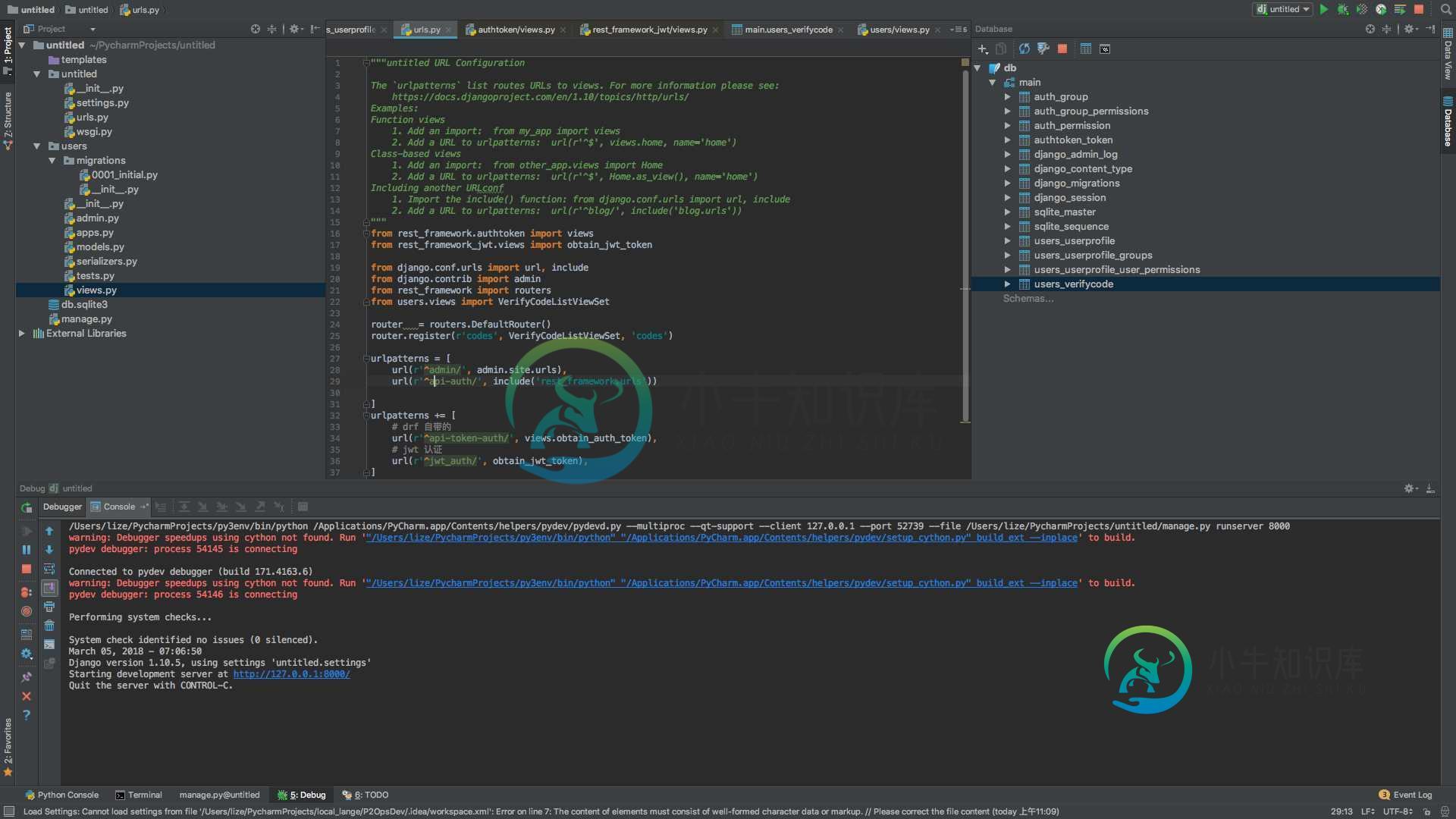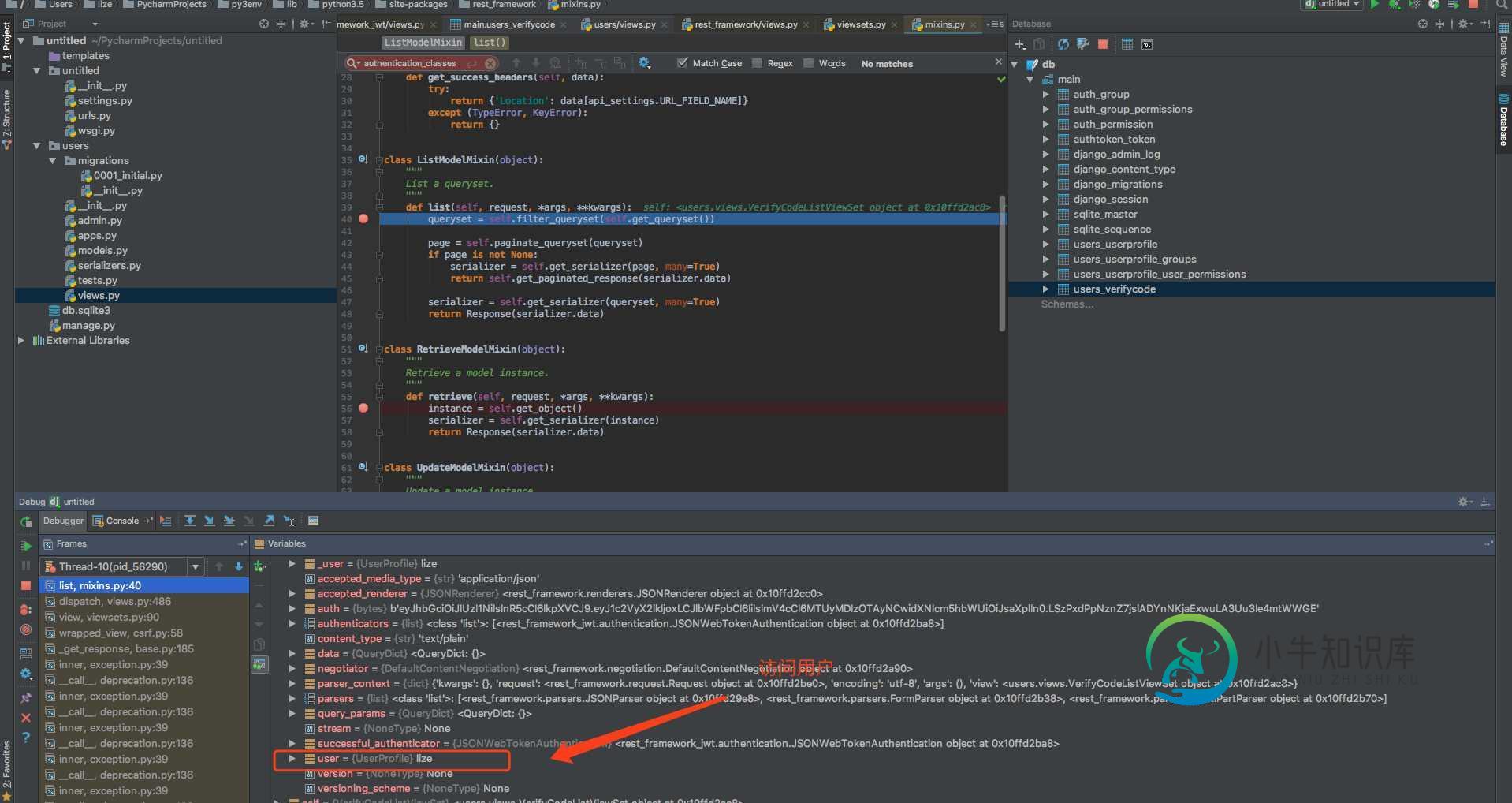Django JWT Token RestfulAPI用户认证详解
一般情况下我们Django默认的用户系统是满足不了我们的需求的,那么我们会对他做一定的扩展
创建用户项目
python manage.py startapp users
添加项目apps
settings.py
INSTALLED_APPS = [ ... 'users.apps.UsersConfig', ] 添加AUTH_USRE_MODEL 替换默认的user AUTH_USER_MODEL = 'users.UserProfile' 如果说想用全局认证需要在配置文件中添加 # 全局认证from rest_framework.authentication import TokenAuthentication,BasicAuthentication,SessionAuthentication REST_FRAMEWORK = { 'DEFAULT_AUTHENTICATION_CLASSES': ( # 'rest_framework_jwt.authentication.JSONWebTokenAuthentication', # 全局认证,开源jwt 'rest_framework.authentication.BasicAuthentication', 'rest_framework.authentication.SessionAuthentication', # 'rest_framework.authentication.TokenAuthentication', #全局认证drf 自带的 ) }
编写model
扩展User model
from django.contrib.auth.models import AbstractUser
from django.db import models
class UserProfile(AbstractUser):
"""
用户
"""
name = models.CharField(max_length=30, null=True, blank=True, verbose_name="姓名")
birthday = models.DateField(null=True, blank=True, verbose_name="出生年月")
gender = models.CharField(max_length=6, choices=(("male", u"男"), ("female", "女")), default="female", verbose_name="性别")
mobile = models.CharField(null=True, blank=True, max_length=11, verbose_name="电话")
email = models.EmailField(max_length=100, null=True, blank=True, verbose_name="邮箱")
class Meta:
verbose_name = "用户"
verbose_name_plural = verbose_name
def __str__(self):
return self.username
编写serializers.py
from rest_framework import serializers from users.models import VerifyCode class VerifyCodeSerializer(serializers.ModelSerializer): class Meta: model = VerifyCode fields = "__all__"
编写views 动态验证不同的请求使用不同的验证
views.py测试
from django.shortcuts import render
from rest_framework import mixins, viewsets
from rest_framework.views import APIView
from users.models import VerifyCode
from .serializers import VerifyCodeSerializer
# Create your views here.
from rest_framework.authentication import TokenAuthentication,BasicAuthentication,SessionAuthentication
from rest_framework_jwt.authentication import JSONWebTokenAuthentication
class VerifyCodeListViewSet(mixins.ListModelMixin,mixins.RetrieveModelMixin, viewsets.GenericViewSet):
"""
验证码列表
"""
queryset = VerifyCode.objects.all()
serializer_class = VerifyCodeSerializer
# authentication_classes = [TokenAuthentication, ]
# authentication_classes = [JSONWebTokenAuthentication, ]
# JWT 认证 加密,过期时间
def get_authenticators(self):
"""
Instantiates and returns the list of authenticators that this view can use.
# 修改验证
"""
# 动态认证
print(self.authentication_classes)
print([JSONWebTokenAuthentication, ])
if self.action_map['get'] == "retrieve":
self.authentication_classes = [BasicAuthentication,SessionAuthentication,]
elif self.action_map['get'] == "list":
self.authentication_classes = [JSONWebTokenAuthentication,]
return [auth() for auth in self.authentication_classes]
# DRF 自带的认证 不过期,易发生xss攻击
# def get_authenticators(self):
# """
# Instantiates and returns the list of authenticators that this view can use.
# # 修改验证
# """
# print(self.authentication_classes)
# print([JSONWebTokenAuthentication, ])
# if self.action_map['get'] == "retrieve":
# self.authentication_classes = [BasicAuthentication,SessionAuthentication,]
# elif self.action_map['get'] == "list":
# self.authentication_classes = [JSONWebTokenAuthentication,]
# return [auth() for auth in self.authentication_classes]
def get_queryset(self):
# 取出认证信息
print(self.request.auth)
# print(self.action)
return self.queryset
# url
"""untitled URL Configuration
The `urlpatterns` list routes URLs to views. For more information please see:
https://docs.djangoproject.com/en/1.10/topics/http/urls/
Examples:
Function views
1. Add an import: from my_app import views
2. Add a URL to urlpatterns: url(r'^$', views.home, name='home')
Class-based views
1. Add an import: from other_app.views import Home
2. Add a URL to urlpatterns: url(r'^$', Home.as_view(), name='home')
Including another URLconf
1. Import the include() function: from django.conf.urls import url, include
2. Add a URL to urlpatterns: url(r'^blog/', include('blog.urls'))
"""
from rest_framework.authtoken import views
from rest_framework_jwt.views import obtain_jwt_token
from django.conf.urls import url, include
from django.contrib import admin
from rest_framework import routers
from users.views import VerifyCodeListViewSet
router = routers.DefaultRouter()
router.register(r'codes', VerifyCodeListViewSet, 'codes')
urlpatterns = [
url(r'^admin/', admin.site.urls),
url(r'^api-auth/', include('rest_framework.urls'))
]
urlpatterns += [
# drf 自带的
url(r'^api-token-auth/', views.obtain_auth_token),
# jwt 认证
url(r'^jwt_auth/', obtain_jwt_token),
]
urlpatterns += router.urls
1. debug模式启动

2. 使用postmain测试

粘贴jwt token 到header中法功请求获取codes列表数据

查看request 中的user可以看到用户代表成功request.auth 可以获得token

调试结束后可以看到结果
以上就是本文的全部内容,希望对大家的学习有所帮助,也希望大家多多支持小牛知识库。
-
本文向大家介绍详解Django之auth模块(用户认证),包括了详解Django之auth模块(用户认证)的使用技巧和注意事项,需要的朋友参考一下 auth模块简介 auth模块是对登录认证方法的一种封装,之前我们获取用户输入的用户名及密码后需要自己从user表里查询有没有用户名和密码符合的对象, 而有了auth模块之后就可以很轻松的去验证用户的登录信息是否存在于数据库中。 除此之外,auth还对
-
简介 除了提供开箱即用的 用户认证 服务外, Laravel 还提供了一种更简单的方式来处理用户的授权动作。 类似用户认证, Laravel 的用户认证方法很简单,并且提供了2种主要方式来实现用户授权:gates 和策略。 可以把 gates 和策略比作路由和控制器。 Gates 提供了一个简单的、基于闭包的方式来进行授权认证,策略和控制器类似,在特定的模型或者资源中通过分组来实现授权认证的逻辑。
-
在开发Web应用过程中,用户认证是开发者经常遇到的问题,用户登录、注册、登出等操作,而一般认证也分为三个方面的认证 HTTP Basic和 HTTP Digest认证 第三方集成认证:QQ、微博、豆瓣、OPENID、google、github、facebook和twitter等 自定义的用户登录、注册、登出,一般都是基于session、cookie认证 beego目前没有针对这三种方式进行任何形式
-
原作者没有写完,但是可以参照下一节,写得很详细 问题 如何完成一个用户认证系统? 解法 用户认证系统由这几个部分组成:用户添加,用户登录,用户注销以及验证用户是否已登录。用户认证系统一般都需要一个数据库。在这个例子中,我们要用到MD5和SQLite。 ## import hashlib import web def POST(self): i = web.input() auth
-
本文向大家介绍Laravel多用户认证系统示例详解,包括了Laravel多用户认证系统示例详解的使用技巧和注意事项,需要的朋友参考一下 前言 自从Laravel5.2开始,自带的Auth认证系统可以支持多个角色认证了。就是说你比如果有管理员、普通用户这两种角色,都可以通过同一个Auth系统来实现认证。 本文将详细给大家介绍关于Laravel多用户认证系统的相关内容,分享出来供大家参考学习,下面话不
-
问题内容: 我有一个将使用flask和mongodb的应用程序;我可能会将其托管在机架空间上。 我需要了解flask验证的工作原理。我没有找到有关此主题的太多信息。是否有有关如何推出自己的解决方案的完整教程?如果不是这样,我当然想听听您flask应用程序的处理方式的一些想法。 大PS: 我只是考虑过 我还需要打开一个真实的API。该API的一部分将在前端用于AJAX。如何保护应用程序的那部分? 谁

